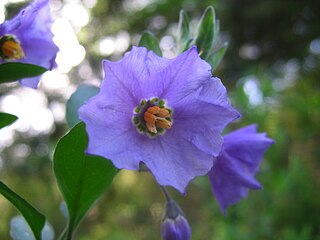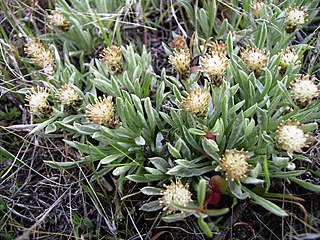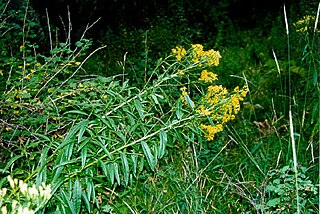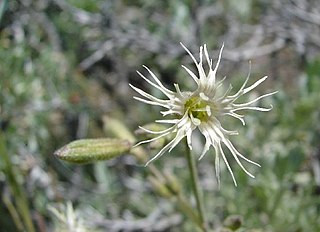
Solanum xanti, known commonly as chaparral nightshade, purple nightshade, and San Diego nightshade, is a member of the genus Solanum. It is native to the Western United States in Arizona, California, Nevada, and Oregon, and to northwest Mexico in Baja California.

Chimaphila menziesii, known by the common names little prince's pine and Little Pipsissewa, is a species of perennial wildflower in the heath family.

Grindelia nana is a species of flowering plant in the daisy family known by the common names Idaho gumplant and Idaho gumweed. It is native to western North America, especially the western United States, where it can be found in a number of dry habitats. This is a weedlike perennial herb growing mainly erect to heights between 20 centimeters and one meter. Its stems and foliage are mostly green with some reddish coloration. Leaves are up to 9 centimeters long. The tops of the stem branches bear flower heads one or two centimeters wide, which are bell-shaped with rounded bases. The head is a cup of green clawlike, curling or erect phyllaries.

Lathyrus polyphyllus is a species of wild pea known by the common name leafy pea. It is native to the western United States from Washington to northern California, where it grows in forest and other habitat. This is a perennial herb with long leaves each made up of many pairs of oval-shaped leaflets a few centimeters long. The leaf also has tendrils which may be long, branched and coiled, or just a short bristle. The stipules are large as well, often over a centimeter wide. The plant produces an inflorescence of up to 12 pea flowers usually arranged in a line along one side of the stem. The flowers are up to 2 centimeters wide and are a variety of shades of purple. The fruit is a dehiscent legume pod containing peas.

Antennaria dimorpha is a North American species of flowering plants in the family Asteraceae known by the common names low pussytoes or gray cushion pussytoes. It is native to western Canada and the western United States as far south as Riverside County in California and Rio Arriba County in New Mexico. It is generally found in dry areas. There are historical records of the species formerly occurring in northwestern Nebraska, but these populations appear now to be gone.
Crepis pleurocarpa is a North American species of flowering plant in the family Asteraceae known by the common name nakedstem hawksbeard. It is native to the western United States (Washington, Oregon, northern California and western Nevada.
Eryngium pinnatisectum is an uncommon species of flowering plant in the family Apiaceae, known by the common names Tuolumne eryngo and Tuolumne button celery.

Pyrrocoma apargioides is a species of flowering plant in the family Asteraceae known by the common name alpineflames. It is native to the western United States from the Sierra Nevada of California east to Utah, where it grows in the forests and meadows of high mountains. It is a perennial herb growing from a taproot and producing one or more stems to 30 centimeters in length. The stems are decumbent or upright, reddish, and hairless to slightly woolly. Most of the leaves are located around the base. They are thick and leathery, lance-shaped with large sawteeth along the edges, often center-striped in white, and measure up to 10 centimeters long. The inflorescence is usually a single flower head lined with centimeter-long phyllaries which are reddish to green with red edges. The head has a center of yellow disc florets and a fringe of ray florets which are yellow, often splashed with red along the undersides, measuring up to 1.6 centimeters in length. The fruit is an achene which may be well over a centimeter in length including its pappus.
Packera bernardina is a rare species of flowering plant in the aster family known by the common name San Bernardino ragwort.
Packera indecora is a species of flowering plant in the aster family known by the common names elegant groundsel and rayless mountain ragwort. It is native to northern North America including most of Canada and sections of the northernmost United States. It grows in moist mountain habitat, such as streamsides and meadows.

Senecio serra is a species of flowering plant in the aster family known by the common names tall ragwort and sawtooth groundsel. It is native to the western United States, where it can be found in several types of habitat, including sagebrush and woodlands. It is a perennial herb producing a single erect stem or a cluster of stems from a branched, woody caudex. The plant can exceed two meters in height. It is hairless in texture, with young plants sometimes appearing fuzzy, and green to red-tinged in color. The leaves have lance-shaped blades up to 20 centimeters long borne on short petioles, the leaves occurring evenly all along the stems. The inflorescence is a spreading array of many flower heads, each lined with green- or black-tipped phyllaries. The heads contain yellow disc florets and 5 to 8 yellow ray florets each under a centimeter long.

Silene douglasii is a species of flowering plant in the family Caryophyllaceae known by the common name Douglas's catchfly.
Silene marmorensis is a rare species of flowering plant in the family Caryophyllaceae known by the common names Marble Mountain catchfly, Marble Mountain campion, and Somes Bar campion. It is endemic to the southern Klamath Mountains of northern California, where it grows in mountain woodlands and forests. It is a perennial herb producing several stems and shoots from a woody, branching caudex and thick taproot. The hairy, glandular stems grow erect to a maximum height near 40 centimeters. The lance-shaped leaves are a few centimeters long and are borne in pairs, the lowermost drying early. The inflorescence is a terminal cyme of flowers at the top of the stem, and some flowers may occur in the leaf axils. Each flower has a hairy, veined calyx of fused sepals. The flowers bloom at night, the five pinkish or green-tinged petals opening at the tip of the calyx.

Silene oregana is a species of flowering plant in the family Caryophyllaceae known by the common names Oregon silene, Oregon campion and Oregon catchfly. It is native to the western United States, including the Great Basin, where it grows in habitat such as sagebrush and forests. It is a perennial herb growing from a woody caudex and taproot, sending up an erect, mostly unbranched stem which may be 70 centimeters tall. The lance-shaped leaves are up to 8 centimeters long around the caudex, and shorter farther up the stem. Flowers occur in a terminal cyme and sometimes in leaf axils. Each flower is encapsulated in a hairy, glandular calyx of fused sepals. The five petals are creamy white or pink-tinged in color and each has four to six long, fringelike lobes at the tip.

Silene sargentii is a species of flowering plant in the family Caryophyllaceae known by the common name Sargent's catchfly. It is native to the western United States, where it is known from the mountain ranges straddling the California-Nevada border east of the Sierra Nevada. It is also known from one disjunct occurrence in central Washington. It grows in rocky mountain habitat in subalpine and alpine climates. It is a perennial herb growing from a woody, branching caudex and taproot, sending up several decumbent or erect stems and shoots. It grows no more than about 20 centimeters tall, often taking a clumpy form. The fleshy leaves are widely lance-shaped and a few centimeters in length, most of them occurring around the caudex. Each flower is encapsulated in a hairy, glandular calyx of fused sepals which has stark purple veining. The petals are white to deep pink and each has two or more rounded or pointed lobes at the tip.
Solanum dimidiatum is a species of plant in the family Solanaceae known by the common names western horsenettle, Torrey's nightshade, and robust horsenettle. It is native to the central United States, where it grows in many types of habitat, including disturbed areas. In California it is known as an introduced species and a noxious weed. It is a rhizomatous perennial herb producing an erect stem up to 80 centimeters tall. It is covered in yellow prickles and branched hairs. The leaves may be up to 15 centimeters long, their edges wavy to lobed and sometimes toothed. The inflorescence is a branching array of several flowers. Each flower has a bell-shaped corolla measuring 3 to 5 centimeters wide. It is lavender to purple, or white. The five large, yellow anthers are about a centimeter long. The fruit is a spherical yellow berry up to 3 centimeters wide.

Solanum parishii is a species of nightshade known by the common name Parish's nightshade. It is native to western North America from Oregon to Baja California, where it grows in many types of habitat, including maritime and inland chaparral, woodlands, and forests. It is a perennial herb or subshrub producing a branching, ribbed or ridged stem up to about a meter in maximum height. The lance-shaped to nearly oval leaves are up to 7 centimeters long and smooth-edged or somewhat wavy. The inflorescence is an umbel-shaped array of several flowers, each borne on a short pedicel. The flower corolla is around 2 centimeters wide when fully open and is usually purple, but sometimes white. At the center are yellow anthers. The fruit is a berry roughly a centimeter wide.
Stellaria irrigua is a species of flowering plant in the family Caryophyllaceae known by the common names umbrella starwort and umbellate starwort. It is native to western North America from Alaska and north-western Canada to the south-western United States, as well as parts of Asia, including Siberia. It grows in subalpine and alpine climates in mountain forests and riverbanks. It is a rhizomatous perennial herb producing a slender prostrate stem up to about 20 centimeters long, sometimes forming clumps or mats. The stem is lined with pairs of oval leaves each up to about 2 centimeters long. The inflorescence is an umbel-shaped array of several flowers each on an arching or erect pedicels. The flower has five pointed green sepals each no more than 3 millimeters long. There are occasionally tiny white petals within the calyx of sepals, but these are generally absent.
Stephanomeria parryi is a species of flowering plant in the family Asteraceae known by the common name Parry's wirelettuce. It is native to the southwestern United States, where it grows in many types of habitat, including many desert areas. It is a perennial herb growing from a thick root and producing one or more slender, upright stems up to about 40 centimeters tall. The green leaves are linear to lance-shaped with lobed edges and are up to 8 centimeters long near the base of the plant. Flower heads occur on the spreading branches. Each has up to 13 or 14 ray florets, each with an elongated tube and a whitish ligule up to 1.5 centimeters long. The fruit is an achene tipped with a spreading cluster of long, tan, plumelike pappus bristles.

Tricardia is a monotypic genus of flowering plants in the borage family containing the single species Tricardia watsonii, which is known by the common name threehearts. It is native to the southwestern United States, where it grows in deserts and mountains in sandy open habitat, often beneath shrubs. It is a perennial herb growing from a taproot and a woody caudex covered with the shreddy remains of previous seasons' herbage. It produces several erect stems up to about 40 centimeters tall. Most of the leaves are located in a basal rosette about the caudex. They are lance-shaped and coated thinly in woolly hairs. They are up to 9 centimeters long and are borne on petioles. A few smaller leaves occur higher on the stem. Flowers occur in a loose cyme at the top of the stem. Each has a calyx of five sepals. The outer three are heart-shaped and green to pink or purple in color, and the inner two are much smaller and narrower. The flower within is bell-shaped, white with central purple markings, and roughly half a centimeter wide. The fruit is a capsule just under a centimeter long which contains 4 to 8 seeds.












